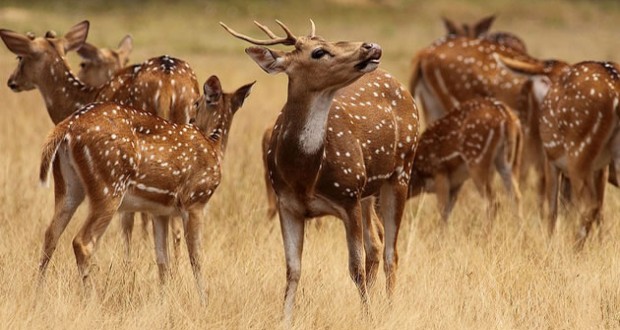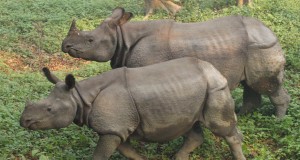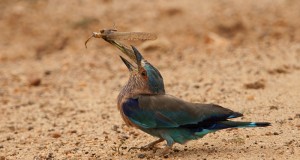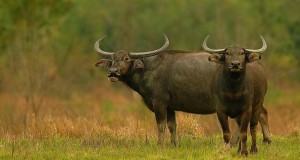Eighteen miles (30 km) south along Route A 12 from the ancient Sri Lankan capital of Anuradhapura is a little evergrowing hamlet amidst green surroundings known as Thmbiriwewa. At this spot is the turn-off to one of Sri Lanka’s most beautiful national parks, Wilpattu.
Two of the main topographical features of this park are its villas and the coppe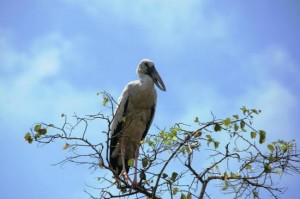 r-red, loamy, fine sand. Villus is a Tamilized version of the Sinhala word Gila meaning lake. Most of the Wilpattu villas are fairly large, spreading over many acres and do indeed look like lakes; they are not true lakes, however, but rather basin-like pans on the earth’s surface. It is interesting to note that Sri Lanka does not have a single natural lake, and all the 11,200 “lakes” or tanks, as they are called, in the north-central area and about 5,000 in the southern sector are man-made, built by ancient monarchs to irrigate the vast agricultural areas.
r-red, loamy, fine sand. Villus is a Tamilized version of the Sinhala word Gila meaning lake. Most of the Wilpattu villas are fairly large, spreading over many acres and do indeed look like lakes; they are not true lakes, however, but rather basin-like pans on the earth’s surface. It is interesting to note that Sri Lanka does not have a single natural lake, and all the 11,200 “lakes” or tanks, as they are called, in the north-central area and about 5,000 in the southern sector are man-made, built by ancient monarchs to irrigate the vast agricultural areas.
These crater-like basins of the villas are peculiar to this sector of the island, and the greatest concentration of them is to be found within the park. They have no ground-water, only what the rains have brought. In fact, at certain spots, almost by the villa, the water table is as far down as 60 feet (20 meters).
Two of the villas within the park are saline: Kokkari and Lunuwila, the latter literally meaning “salt lake.” There is still no satisfactory explanation as to how these became salty, but it could be due to a constituent in the soil which becomes progressively concentrated as rain follows drought and so on. The degree of salinity of these villas is as high as that of the sea.
Watching at Villus: Almost all the vi/us are surrounded by parkland and ‘are very rich in scenic beauty. They are the finest places in the park to observe animal and bird life, especially in the mornings and evenings. Even on those chance occasions when one does not encounter any animal life at the villas, it is still worthwhile to drive around and absorb the beauty and the serene atmosphere.
Another striking characteristic of the park, confined to the western sector, is the red sand, so fine that it will go through the finest of sieves. This sand blankets the western coast o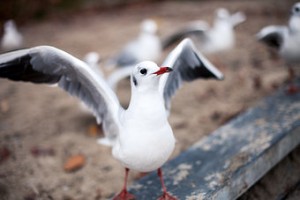 f the island from north of Chilaw to about Mannar and is as characteristic to this part of the coast as the white cliffs are to Dover. It is this coppery loam that prompted the ancient mariners, blown to the west coast by the southwest trade winds, to call the island Tambapanni, the “land of copper sand.”The park has a fairly varied forest pattern. A better part of it is deep secondary forest, but opening out at intervals into sandy glades. The dry thornbush country, reminiscent of Yala, is found in the western sector. Large sand dunes and beds are found throughout the park, where one finds hints of a past submarine land, perhaps during the Middle Tertiary Period.
f the island from north of Chilaw to about Mannar and is as characteristic to this part of the coast as the white cliffs are to Dover. It is this coppery loam that prompted the ancient mariners, blown to the west coast by the southwest trade winds, to call the island Tambapanni, the “land of copper sand.”The park has a fairly varied forest pattern. A better part of it is deep secondary forest, but opening out at intervals into sandy glades. The dry thornbush country, reminiscent of Yala, is found in the western sector. Large sand dunes and beds are found throughout the park, where one finds hints of a past submarine land, perhaps during the Middle Tertiary Period.
Leopards: The leopards of Wilpattu, for which the park is famous, are not as shy as those at Yala. Often, they walk up to a vehicle. Visitors are, however, well advised to stay as quiet as possible and to avoid any sudden movement when a leopard is in the immediate vicinity. The best time to see these magnificent cats is the early morning hours and the late evenings. Keep a sharp look out in the sandy areas and the edge of the villas as you drive around, and let your eyes wander up those magnificent umbrellashaped trees also.
Though not seen as often as leopard, bears too can be observed fairly easily in this park, if conditions are not too dry. However, if one is specially keen on seeing bears, one should plan the visit around late May and June when the palu ( Manilkara hexandra) and the veera ( Drypetus sepieria) arc in fruit. If you have a sharp shower of rain while you are in the park, get on the track about an hour later and carefully approach the anthills that litter the park, and you are bound to see Mr Bruin sucking up their occupants with his long snout, like a vacuum cleaner. The water holes too are frequented by bears during the late mornings as the sun gets warmer.
Wilpattu is not elephant country, yet there is a fair population of these great cr eatures within the park, and also herds that migrate in and out. But one hardly ever sees them here as they arc extremely shy and prefer to stay well under cover during the daylight hours, though, on rare occasions, some lucky visitors have encountered large herds. The occasional loners are known to visit the lodges if there isn’t too much disturbance from the occupants. The lodge at Valli Villu would be the finest place to see elephants from during the dry months, and herds of over 30 have been seen from here. A day spent at Pomparippu in the western sector during this period may also bring results.
eatures within the park, and also herds that migrate in and out. But one hardly ever sees them here as they arc extremely shy and prefer to stay well under cover during the daylight hours, though, on rare occasions, some lucky visitors have encountered large herds. The occasional loners are known to visit the lodges if there isn’t too much disturbance from the occupants. The lodge at Valli Villu would be the finest place to see elephants from during the dry months, and herds of over 30 have been seen from here. A day spent at Pomparippu in the western sector during this period may also bring results.
The extremely shy and wary barking deer and mouse deer can both be seen in Wilpattu more easily than anywhere else in the island. This will, however, need a bit of special effort. One will have to spend some time watching quietly at a water hole (your guide will recommend a good one), and your efforts will be rewarded before long. While touring the villas, watch for the crocodiles and water monitors. Even the two saline villas have crocodiles in them, and some of them are exceptionally large. Birds: During the migratory season, Wilpattu is packed with birds. Even at other ti mes, due to the conditions in the park, almost all avian types in the island, except those that are confined to the hills, can be seen. The best places to observe birds from is the villas, and the little water holes which are fairly deep in the jungle but easily accessible. In the deeply forested areas one will come across the more uncommon types such as the red faced malkoha, the Ceylon trogon and the shama. Birds of prey are numerous, and lodge residents should keep a weather-eye open for the magnificent forest eagle owl.
There are seven lodges in the park, Maradanmaduwa, Pannikar Villu, Valli Villu, Mana Gila, Thala Gila, Manila Pola Uttu and Kokmottai. All except the last are beautifully situated, facing large lotus-filled villus. Kokmottai is on the bank of the Modaragarn Aru river whose waters offer the visitor a cool, very safe and refreshing dip.
Driving Around: The park is interlaced with about 150 miles (240 km) of dryweather track. The main track and also tracks to some of the bigger villus can be approached and traversed by motorcar during dry times and even after moderate rain, but due to 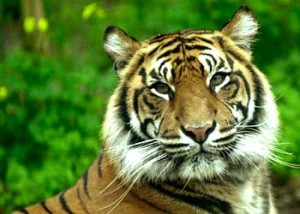 the very sandy terrain the visitor who wishes to see most of the park is advised to use a four-wheel drive vehicle. Unless one is a very keen wildlife observer or photographer, the best way of seeing game in the park would be to drive around the villus areas in a vehicle. For the enthusiast or the wildlife photographer, there is a hide at a water hole named Danggaha Uraniya which one can reserve for the day. Sitting there silently and patiently can be very rewarding. There are two other water holes with hides, namely Cheena Uttu and Menikrala Uraniya accessible by four-wheel drive vehicle. Prior reservation is not required.
the very sandy terrain the visitor who wishes to see most of the park is advised to use a four-wheel drive vehicle. Unless one is a very keen wildlife observer or photographer, the best way of seeing game in the park would be to drive around the villus areas in a vehicle. For the enthusiast or the wildlife photographer, there is a hide at a water hole named Danggaha Uraniya which one can reserve for the day. Sitting there silently and patiently can be very rewarding. There are two other water holes with hides, namely Cheena Uttu and Menikrala Uraniya accessible by four-wheel drive vehicle. Prior reservation is not required.
Spending the night in any one of the lodges would be an experience, but a night or two at Thala Wila, Mana Wila or Pannikar Villu could be especially memorable as leopards and bears have been seen just a couple of feet from the verandahs. To encourage these animals to visit, all lamps and conversation should be kept down to the lowest possible level.

